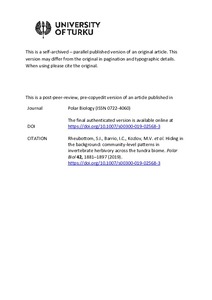Hiding in the background: community-level patterns in invertebrate herbivory across the tundra biome
Tommi Andersson; Mikhail V. Kozlov; Dorothee Ehrich; Capucine Baubin; Otso Suominen; Vitali Zverev; Juha M. Alatalo; James D. M. Speed; Guillaume Slevan-Tremblay; Sarah I. Rheubottom; Esther Lévesque; Janet S. Prevéy; Natalia Sokolova; Johan Olofsson; Ashley L. Asmus; Francis Q. Brearley; Isabel C. Barrio; Aleksandr Sokolov; Sophia Konieczka; Gilles Gauthier; David S. Hik; Svetlana Sokovnina; Ingibjörg Svala Jónsdóttir; Dagmar D. Egelkraut
https://urn.fi/URN:NBN:fi-fe2021042821944
Tiivistelmä
Invertebrate
herbivores depend on external temperature for growth and metabolism.
Continued warming in tundra ecosystems is proposed to result in
increased invertebrate herbivory. However, empirical data about how
current levels of invertebrate herbivory vary across the Arctic is
limited and generally restricted to a single host plant or a small group
of species, so predicting future change remains challenging. We
investigated large-scale patterns of invertebrate herbivory across the
tundra biome at the community level and explored how these patterns are
related to long-term climatic conditions and year-of-sampling weather,
habitat characteristics, and aboveground biomass production. Utilizing a
standardized protocol, we collected samples from 92 plots nested within
20 tundra sites during summer 2015. We estimated the community-weighted
biomass lost based on the total leaf area consumed by invertebrates for
the most common plant species within each plot. Overall, invertebrate
herbivory was prevalent at low intensities across the tundra, with
estimates averaging 0.94% and ranging between 0.02 and 5.69% of plant
biomass. Our results suggest that mid-summer temperature influences the
intensity of invertebrate herbivory at the community level, consistent
with the hypothesis that climate warming should increase plant losses to
invertebrates in the tundra. However, most of the observed variation in
herbivory was associated with other site level characteristics,
indicating that other local ecological factors also play an important
role. More details about the local drivers of invertebrate herbivory are
necessary to predict the consequences for rapidly changing tundra
ecosystems.
Keywords
Background herbivory Biomass loss Climate change Community-weighted average Invertebrate Insects TundraKokoelmat
- Rinnakkaistallenteet [19207]
